Omers Energy Inc. v. Alberta (Energy Resources Conservation Board)
Omers Energy Inc. v. Alberta (Energy Resources Conservation Board)
Omers Energy Inc. v. Alberta (Energy Resources Conservation Board)
- No tags were found...
Create successful ePaper yourself
Turn your PDF publications into a flip-book with our unique Google optimized e-Paper software.
Page: 12whenever steps can be taken to address that well’s conditions or the reservoirsconditions to achieve any production flow whatsoever.”[49] Furthermore, <strong>Omers</strong> takes issue with the <strong>Board</strong>’s test of “meaningful quantities” because itsays the phrase “meaningful” is elusive; it also strongly opposes reading in the words “producingin commercial or paying quantities” when the parties have chosen not to put these words in the lease.[50] Montane says that “capable of producing” means capable of producing on a sustained basisquantities that are sufficiently meaningful to provide an incentive to produce. Montane argues thatthe fact that there is positive pressure at the casing head of the well annulus is not sufficient torender a well capable of producing leased substances. Montane points out that in May andNovember 2006, <strong>Omers</strong> had attempted to get gas to flow on a sustained basis without success, andto suggest that such a well is “producing” within the meaning of the <strong>Omers</strong> lease is absurd. Montanesubmits that the shut-in clause provides only that the lease will continue when the well is capableof producing, or where operations are being conducted, language that would not be necessary if“capable of producing the leased substances” covered wells that needed to undergo operations inorder to obtain or maintain production.[51] The intervener argues that the phrase “capable of producing the leased substances” shouldbe read as “capable of producing the leased substances in paying quantities” (emphasis added). Shenotes that the extent of the production necessary to satisfy the <strong>Board</strong>’s interpretation received littleelaboration except for the <strong>Board</strong>’s assertion that the relevant factors in each individual case willgovern. The intervener submits that in the absence of governing case law in Canada, reference tothe American authorities is appropriate. In relying on such authorities, the intervener takes the viewthat “there is no comprehensible motivation for entering an oil and gas lease outside of the potentialfor economic gain.”2. The “paying quantities” argument[52] I propose, first, to deal with Cymbaluk’s argument that “capable of producing” meansproducing in “paying quantities”. Cymbaluk argues that the objective of this lease is the commondesire to profit from the development of the resource, and that this provides a rationale to supportthe term “capable of production in paying quantities”. Without such wording, or a comparableproviso, a lessor would have no incentive to grant a lease that could tie up property forever withoutany realistic hope of profit. Accordingly, she submits we should interpret the clauses consistent withpractical reality – namely, that the lessor would not have agreed to extend the term of the leaseabsent production in paying quantities. Cymbaluk relies upon American authority to support herargument and submits that in rejecting this test the <strong>Board</strong> misunderstood the distinction between“paying quantities” and “commercial quantities”. At para 26 of her factum, Cymbaluk states:The fundamental theory of the petroleum and gas lease is that the parties shouldbe entitled to reap the benefits of their respective investments. If a well canproduce in paying quantities, then presumably the lessee will only suspend or shutin the well for valid business reasons. However, once a well cannot produce in
















